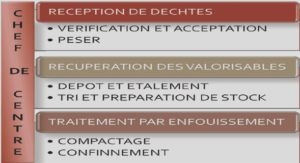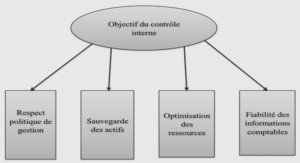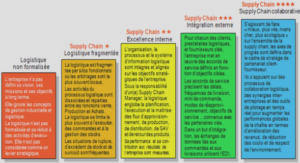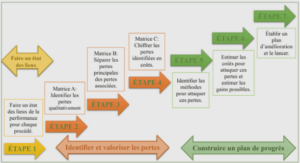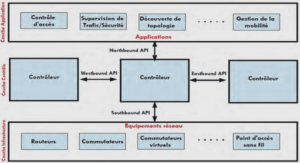Problem definition
Currently, the RM model does not allow for the accommodation of RS scenarios such as the one described in Figure 1.3 below where (E) sends money to (R) with a mandate to acquire a service from a service provider (S) for himself or a third party beneficiary (B). In the scenario above, the RM model does not discriminate between: 1) the recipient authorized to collect the money (R); 2) the service provider to be paid with the money transferred (S); and 3) the intended beneficiary of the service to be acquired with the money remitted (B). These are 3 distinct roles with different expectations. While in certain cases these roles might be imbued to the same person, most often they are not. The person collecting the money acts as a forwarding channel for the money to reach its intended destination, which is the service provider. The recipient of the money (R) may or may not be the beneficiary of the service provided. For example, when a parent (E) sends money to his/her child to pay for school fees, the child is the recipient of the money (R), and in this case, also the money forwarding channel toward the school, which is the intended destination for receipt of the money (S), despite the fact that the child is the beneficiary of the service provided (B).
Also, it has to be noted that even though the child is in this case the recipient and the ultimate beneficiary of the service to be acquired, he might still decide not to use the money to pay for school once he pockets it. In doing so, he will interfere with the purpose of the money transferred, as originally intended by the parent (E). The example above shows that when an RM transaction is used to conduct an RS transaction, the entire transaction is based on two assumptions: 1) the expeditor (E) trusts the recipient (R) to pay for a service (S) for the benefit of the beneficiary (B); and 2) that expeditor (E) trusts that (B) will always honor the intended use of the money in acquiring the service provided by (S). Regrettably, these assumptions of trust made by the expeditor (E) have often proven false, with adverse consequences for both the expeditor and the beneficiary. This research intends to address this problem. In the Trusted Remittance of Service (TRS) model that is the focus of this thesis, no assumption regarding the trustworthiness of the money recipient or beneficiary is made. A remittance transaction is considered completed only when the beneficiary receives the service paid for with the remittance money as expected by the expeditor, and, unlike in an escrow account, with the assurance that no third party will interfere. The participants transact between themselves without third party interference using online and distributed technology with the confidence that the entire system can be trusted.
Remittance from the expeditor’s perspective
The assessment of the remittance from the expeditor’s point of view was done with interviews and desk research. This section illustrates the current situation by providing examples from transactions with Western Union, the biggest MTO market player in the DRC (Figure 2.7). The research has shown that as there was remittance money coming from abroad to the DRC, remittance money was also being sent from the DRC to other countries. And these two groups shared the same set of concerns, although their experience interacting with an MTO was different. The overall impression gathered from survey results is that sending money is quite easy for an expeditor from overseas sending money to the DRC. All international MTOs channeling money into the DRC provide secure websites from which expeditors can transfer money using credit or debit cards. However, the cost of an international transfer to the DRC is perceived as expensive. Figure 2.8: Sent remittance purpose (Maketa,2018) Expeditors from within the DRC sending money abroad do not benefit from similar tools, mostly because the culture of using online applications and paying via credit card is not as widespread in the community and the MTOs do not see the interest in providing that service.
In Figure 2.8, the remittance purpose for expeditors from within DRC is illustrated and can be compared to Figure 2.3, which describes the purpose of remittance money received from abroad. It is interesting to see the similarity between these two figures. This implied that the cause of remittance from and to DRC are very similar and are related to providing money to family or children, to help them attend to their basic needs. It should be noted that expeditors sending money from within the DRC share the same experience interacting with an MTO office as the beneficiary of remittance money, as described in the section 2.2. They also have to commute to an MTO retail store and wait while in there, whereas having cellphones could make their life easier. Figure 2.9: Western Union fine print on Exchange rate cost (Western-Union, 2019) Expeditors from abroad sending money to the DRC, face another set of realities. In the DRC, international remittance transactions are paid for locally in US dollars because of the high volatility of the local currency, and, for transfers from countries other than the USA, MTOs incorporate currency exchange costs in addition to the visible transaction fee, as explained in the subscript at the bottom of the transfer contract (Figure 2.9). Western Union and other MTOs, receive additional benefits from transaction exchange fees that constitute another source of revenue due to the large sums of money that is exchanged every day. The exchange rate varies daily and each MTO fixes its own rate.
For instance, a transfer done from Canada to the DRC, on the 6th of October 2019, shows that there is a $0.000525 USD difference between the rate displayed on the Western Union website of $1 CAD = $0.7508 USD (Figure 2.10) and the indicative rate provided by Xe, a leading exchange rate provider of $1 CAD = $0.751325 USD (Figure 2.11).
This means that for a $999.95 CAD transfer to the DRC (the maximum amount authorized to be sent online from the Western Union Canada website), the expeditor loses $0.52. That is an amount, however minimal, that should have gone to the recipient and not to Western Union. In addition to this exchange rate cost, there are transfer fees. For example, Figures 2.12 and 2.13 show that on October 6, 2019, Western Union reported charging, on its online website, a fee of $15 for a $200 USD transfer from the USA to the DRC (7.5% of the transfer amount) and a fee of $81 for a transfer of $1000 USD (8.1% of the transfer amount) (Western-Union, 2019). That is far greater than the 3% advocated by the UN and more than the average global transfer fee of 6.1 % for 2019 (Figure 2.14). Additional information was related during interviews regarding the lack of “trust” about the intended use, by the receiver, of a remittance. The expeditor described that he has no guarantee that the money sent would be used for its original intention. As soon as the beneficiary retrieves the cash from the MTO retail office, the expeditor loses control over the money and must rely solely on the good faith of the receiver to use the money for its agreed/intended purpose.
This introduces the notion of a “trust hazard” for the expeditor. The expeditor related that the recipient could perpetrate abuses that are difficult for the expeditors to discover since they live in different countries or continents. As seen above, one can note that the average amount of money sent to the DRC is between $50 and $500 USD (Figure 2.6), which is quite substantial considering that a teacher earns only $100 US dollar monthly. 99% of that money (Figure 2.3) is sent for attending to daily subsistence needs (groceries, transport) or to pay for education and health services for the expeditors’ friends and family, and the expeditor has no way to ensure that the money sent is used for its intended purpose. This applies also for expeditors from within DRC sending money abroad. Consequently a remittance transaction is somewhat risky from an expeditor’s point of view. This risk is compounded if the person who collects the money is not the intended end beneficiary; for example, a grandson collecting money for the health expenses of his grandmother.
In conclusion, reducing for tTCR he beneficiary and reducing the trust hazard for the expeditor of a remittance transaction are the main observations of the field research. Using the information provided by the survey, this research focuses on the issue of how to reduce the trust hazard the expeditor of a remittance perceives when he initiates a remittance of service transaction for an intended use. This issue has been chosen because all the other concerns, such as reducing the cost of the transaction, or reducing the total cost of the remittance (TCR), can be solved by either commercial decisions, MTOs reducing their fees, or by using a mobile based application that would allow for the provision of remittance services without the beneficiary having to commute, or frequently wait in line to collect their money. Addressing the trust hazard is challenging. There were no remittance models available at the time of writing this thesis to address this problem. Addressing the trust hazard needs a change 25 in the remittance model. The current remittance model as observed in the field includes as actors the money transfer operator, the emitter and the beneficiary. To address the trust hazard, the model should also include the service provider. This is a key insight that is used in the Trusted Remittance of Service model that will be seen in Chapter 5. While attempting to solve this trust hazard, there is also an opportunity that the proof of concept that will implement the newly proposed remittance model could address the other issues raised during the field survey as well, especially issues concerning the reduction of transaction and foreign exchange costs and the issue of enhancing the user’s experience regarding a remittance. The next chapter presents the literature review of the different concepts and the current state of the art in the domain of remittances such as trust in distributed systems, consensus, blockchain, proof of work, cryptographic keys, gas and many related topics.
INTRODUCTION |


